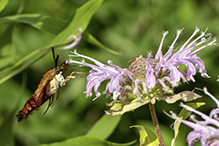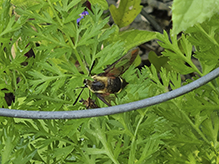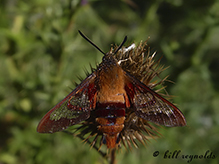hummingbird clearwing
(Hemaris thysbe)
Conservation • Description • Habitat • Ecology • Distribution • Taxonomy
|
||||||||
| Hodges # | 7853 |
|||||||
Conservation Status |
||||||||
| IUCN Red List | not listed |
|||||||
| NatureServe | N5 - Secure SNR - Unranked |
|||||||
| Minnesota | not listed |
|||||||
Description |
||
Hummingbird clearwing is a common, medium to large, sphinx moth. In poor light or at a distance it is easily mistaken for a hummingbird, due to similarities in both appearance and behavior. It has a wingspan of 1 9 ⁄16″ to 2 3 ⁄16″. When the adult first emerges from the cocoon the wings are completely covered with dark wine-red scales. The scales begin to drop off with the first flight, eventually leaving the wings clear except on the margins and along the veins. The forewing is long and narrow with a smooth, slightly convex outer margin. The forewing cell is boldly outlined and is either mostly covered with dark scales or is bisected by a thin, dark line that looks like, but is not, a vein. The appendage (tegula) covering the forewing base is olive green. The thorax is unbanded, olive green above, and yellow below. The abdomen is banded with five colors. Abdominal segments 1 and 2 are olive green; segments 3 through 5 are tan with a few olive-green hairs; segments 6 and 7 are dark wine-red; segments 8 and 9 are olive green, often with a small to large, dark wine red patch in the middle; and segment 10 is black. Tufts of long hairs flare outward from the tenth abdominal segment and look like feathers. The head is olive green. The antennae are black, thickened, and club-like. The proboscis is long and is coiled under the head when not in use. The legs are yellowish or pale colored. The legs are pale. The caterpillar is lime green and up to 2″ long. The head, thorax, and abdominal segments 1 through 7 and 10 are moderately covered with prominent, minute, white bumps. Abdominal segments 8 and 9 have much fewer, scattered, less prominent bumps. The leading edge of the thorax has a yellow, warty collar. A long, curved, often bluish horn extends from the eighth abdominal segment. A yellow subdorsal stripe extends from the first thoracic segment to the horn. The spiracles are white with a red center and an orange base. The leg-like structures (prolegs) on the abdomen are yellow at the base, black in the middle, and green at the end with an brownish-red band. Mature caterpillars can be found from May onward. |
||
Size |
||
Wingspan: 1 9 ⁄16″ to 2 3 ⁄16″ Total length: 1″ to 1 3 ⁄16″ |
||
Similar Species |
||
Snowberry clearwing (Hemaris diffinis) legs are black. |
||
Habitat |
||
Meadows, gardens, woodland openings. |
||
Ecology |
||
Season |
||
Two broods: May to September |
||
Behavior |
||
Adults fly during the day. |
||
Life Cycle |
||
Females attract males by releasing pheromones. After mating, she lays spherical green eggs on the underside of host leaves. The eggs hatch in about one week and the caterpillars begin feeding on leaves and fruit of the host plant. They molt five times in four weeks before pupating. The first generation pupates in a cocoon among the leaf litter on the ground. Adults emerge two to four weeks later. The second generation caterpillar burrows into the soil and overwinters as a pupa and emerges in as an adult in May or June. |
||
Larva Hosts |
||
Mostly viburnum (Viburnum spp.), but also honeysuckle (Lonicera spp.), snowberry (Symphoricarpos), hawthorn (Crataegus spp.), and cherry (Prunus spp.). |
||
Adult Food |
||
Flower nectar. |
||
Distribution |
||||
|
Sources |
|||
| 8/6/2022 | ||||
Occurrence |
||||
|
||||
Taxonomy |
|||
Order |
Lepidoptera (Butterflies and Moths) | ||
Superfamily |
Bombycoidea (Hawk, Sphinx, Silk, Emperor, and Allied Moths) | ||
Family |
Sphingidae (sphinx moths) | ||
Subfamily |
Macroglossinae | ||
Tribe |
Dilophonotini | ||
| Subtribe | Hemarina | ||
Genus |
Hemaris (clearwings and bee hawkmoths) | ||
Synonyms |
|||
|
|||
Common Names |
|||
common clear-wing hummingbird clearwing hummingbird clearwing moth hummingbird moth sphinx colibri |
|||
Glossary
Anal plate
In snakes: the large scale in front of and covering the anus. In turtles: one of the posterior plates of the lower shell (plastron). In Lepidoptera: the often hardened shield on the dorsal surface of the last (10th) segment of the abdomen.
Proleg
A fleshy structure on the abdomen of some insect larvae that functions as a leg, but lacks the five segments of a true insect leg.
Prothoracic shield
The hardened plate on the dorsal surface of the first segment of the thorax.
Tegula
A small, hardened plate or flap-like structure that overlaps the base of the forewing of insects in the orders Lepidoptera, Hymenoptera, Diptera, and Homoptera.
Visitor Photos |
|||||
Share your photo of this insect. |
|||||
| This button not working for you? Simply email us at info@MinnesotaSeasons.com. Attach one or more photos and, if you like, a caption. |
|||||
Luciearl |
|||||
I had only seen one in my life, now 3 within one week. It was attracted to the wild bergamot. |
 |
||||
M Farrell |
|||||
July 2023 feeding in our prairie restoration |
|||||
 |
 |
||||
 |
 |
||||
Linda W. |
|||||
We had 2 of the hummingbird clearwings enjoying the nectar from our perennials today. Love their intricate wings! |
 |
||||
Karen |
|||||
 |
|||||
Nanc |
|||||
Spotted in my vegetable garden. |
|||||
 |
 |
||||
Bobbi Johnson |
|||||
 |
|||||
Alfredo Colon |
|||||
 |
 |
||||
Rick Thome |
|||||
 |
|||||
Chuck Ward |
|||||
On Perennial Pollinator |
|||||
 |
 |
||||
 |
 |
||||
Colin Warren |
|||||
Snacking on some Persian Cat Mint |
|||||
 |
|||||
Norm & Peg Dibble |
|||||
Sphinx Moth, 2017 |
|||||
 |
|||||
Jane W |
|||||
Feeding on shaded impatiens flowers |
|||||
 |
|||||
Bill Reynolds |
|||||
| Found this Clearwing Hummingbird moth this morning after it spent the night hanging onto a dried thistle bloom. |  |
||||
 |
 |
||||
 |
|||||
Tom Baker |
|||||
 |
 |
||||
 |
 |
||||
MinnesotaSeasons.com Photos |
|||||
 |
|||||


Visitor Videos |
|||
Share your video of this mammal. |
|||
| This button not working for you? Simply email us at info@MinnesotaSeasons.com. Attach a video, a YouTube link, or a cloud storage link. |
|||
Other Videos |
|||
| hummingbird clearwing moth (Hemaris thysbe) KillerChicken |
|||
About
Uploaded on Aug 29, 2006 This hummingbird clearwing moth has been lurking in my garden for a week or so now. It was so intent on feeding it didn't care how close we approached it. |
|||
| Hemaris thysbe caterpillar The Urban Gardener |
|||
About
Published on Nov 1, 2013 No description available. |
|||
| The Hummingbird Clearwing Moth cmnsns |
|||
About
Uploaded on Jun 17, 2011 Hemaris thysbe, the Hummingbird Clearwing Moth or Common Clearwing |
|||


Last Updated:
















